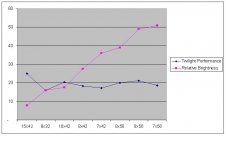Yippeekiay
Well-known member
Hi All,
Another quick question.
All things being equal (i.e.lense and coating quality) which has the greater effect on low light performance.. A larger objective lense or a lower power magnificaton? Essentially I'm looking at 7x50 or 8x56 and wondering which will be better in the twilight hours. Thanks!
Afterthought: What exactly determines a set of binoculars depth of field. It seems porro's have the lead where this is concerned and as usual it got me to wondering. Off topic I realize but I didn't want to flood the place w/ questions.
Another quick question.
All things being equal (i.e.lense and coating quality) which has the greater effect on low light performance.. A larger objective lense or a lower power magnificaton? Essentially I'm looking at 7x50 or 8x56 and wondering which will be better in the twilight hours. Thanks!
Afterthought: What exactly determines a set of binoculars depth of field. It seems porro's have the lead where this is concerned and as usual it got me to wondering. Off topic I realize but I didn't want to flood the place w/ questions.
Last edited:




